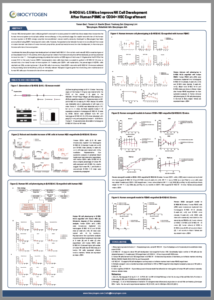IO Summit: B-NDG hIL-15 Mice Improve NK Cell Development After Human PBMC or CD34+ HSC Engraftment

Human HSC (hematopoietic stem cells) engrafted humanized mice are a powerful model that allows researchers to examine the human immune system and evaluate cellular immunotherapy in the preclinical stage. Successful reconstitution of the human immune system in B-NDG mice (a complete immunodeficient mouse model previously developed by Biocytogen) has been accomplished using CD34+ hematopoietic stem cells. However, the species barrier between human immune cells and the mouse microenvironment can obstruct human immunity acquisition, as well as innate immune function development, in the mice upon the reconstitution of immune system.
To address this issue, Biocytogen has developed and validated the B-NDG hIL15 mice that combines a B-NDG mouse background and expresses human IL15 cytokine, which plays important roles in the innate and adaptive cell homeostasis, as well as peripheral immune function [1, 2] . The targeting strategy stipulates the insertion of CDS region of the human IL15 gene after the 5′UTR of the mouse Il15. In this work, human CD34+ hematopoietic stem cells have been successfully grafted in B-NDG hIL15 mice, to reconstitute a functional human immune system. At 4 weeks post CD34+ cell implantation, the percentage of hCD45+ cells reached over 25%, containing human T, B, and NK cells. In summary, these CD34+ reconstituted B-NDG hIL15 mice are validated to be promising tools for the efficacy study of clinically relevant therapeutic agents given the mice’s long-term maintenance of human NK cells upon the reconstitution of immune system.


